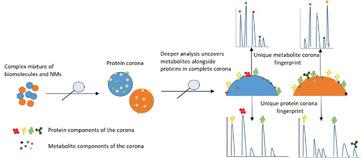Our official English website, www.x-mol.net, welcomes your feedback! (Note: you will need to create a separate account there.)
The Nanomaterial Metabolite Corona Determined Using a Quantitative Metabolomics Approach: A Pilot Study.
Small ( IF 13.3 ) Pub Date : 2020-04-02 , DOI: 10.1002/smll.202000295 Andrew J Chetwynd 1, 2 , Wei Zhang 3 , James A Thorn 1 , Iseult Lynch 2 , Rawi Ramautar 3
Small ( IF 13.3 ) Pub Date : 2020-04-02 , DOI: 10.1002/smll.202000295 Andrew J Chetwynd 1, 2 , Wei Zhang 3 , James A Thorn 1 , Iseult Lynch 2 , Rawi Ramautar 3
Affiliation

|
Nanomaterials (NMs) are promptly coated with biomolecules in biological systems leading to the formation of the so‐called corona. To date, research has predominantly focused on the protein corona and how it affects NM uptake, distribution, and bioactivity by conferring a biological identity to NMs enabling interactions with receptors to mediate cellular responses. Thus, protein corona studies are now integral to nanosafety assessment. However, a larger class of molecules, the metabolites, which are orders of magnitude smaller than proteins (<1000 Da) and regulate metabolic pathways, has been largely overlooked. This hampers the understanding of the bio–nano interface, development of computational predictions of corona formation, and investigations into uptake or toxicity at the cellular level, including identification of molecular initiating events triggering adverse outcome pathways. Here, a capillary electrophoresis–mass spectrometry based metabolomics approach reveals that pure polar ionogenic metabolite standards differentially adsorb to a range of 6 NMs (SiO2, 3 TiO2 with different surface chemistries, and naïve and carboxylated polystyrene NMs). The metabolite corona composition is quantitatively compared using protein‐free and complete plasma samples, revealing that proteins in samples significantly change the composition of the metabolite corona. This key finding provides the basis to include the metabolite corona in future nanosafety endeavors.
中文翻译:

使用定量代谢组学方法确定的纳米材料代谢物电晕:一项初步研究。
纳米材料(NMs)在生物系统中迅速被生物分子包覆,导致形成所谓的电晕。迄今为止,研究主要集中在蛋白质电晕及其如何通过赋予NM生物学特性,使其能够与受体相互作用来介导细胞反应,从而影响NM摄取,分布和生物活性。因此,蛋白质电晕研究现已成为纳米安全性评估不可或缺的一部分。但是,很大程度上忽略了一类较大的分子,即代谢产物,其代谢产物比蛋白质(<1000 Da)小几个数量级,并调节代谢途径。这妨碍了对生物-纳米界面的理解,电晕形成的计算预测的发展以及对细胞水平上的摄取或毒性的研究,包括识别触发不良结局途径的分子引发事件。在这里,基于毛细管电泳-质谱的代谢组学方法揭示了纯极性离子源代谢产物标准品在6 NMs(SiO2,3的TiO 2具有不同的表面化学性质,以及幼稚的和羧化的聚苯乙烯NMs。使用不含蛋白质的血浆样品和完整血浆样品定量比较了代谢产物电晕的组成,结果表明样品中的蛋白质会显着改变代谢产物电晕的组成。这一重要发现为将代谢产物电晕纳入未来的纳米安全研究提供了基础。
更新日期:2020-04-02
中文翻译:

使用定量代谢组学方法确定的纳米材料代谢物电晕:一项初步研究。
纳米材料(NMs)在生物系统中迅速被生物分子包覆,导致形成所谓的电晕。迄今为止,研究主要集中在蛋白质电晕及其如何通过赋予NM生物学特性,使其能够与受体相互作用来介导细胞反应,从而影响NM摄取,分布和生物活性。因此,蛋白质电晕研究现已成为纳米安全性评估不可或缺的一部分。但是,很大程度上忽略了一类较大的分子,即代谢产物,其代谢产物比蛋白质(<1000 Da)小几个数量级,并调节代谢途径。这妨碍了对生物-纳米界面的理解,电晕形成的计算预测的发展以及对细胞水平上的摄取或毒性的研究,包括识别触发不良结局途径的分子引发事件。在这里,基于毛细管电泳-质谱的代谢组学方法揭示了纯极性离子源代谢产物标准品在6 NMs(SiO2,3的TiO 2具有不同的表面化学性质,以及幼稚的和羧化的聚苯乙烯NMs。使用不含蛋白质的血浆样品和完整血浆样品定量比较了代谢产物电晕的组成,结果表明样品中的蛋白质会显着改变代谢产物电晕的组成。这一重要发现为将代谢产物电晕纳入未来的纳米安全研究提供了基础。



























 京公网安备 11010802027423号
京公网安备 11010802027423号